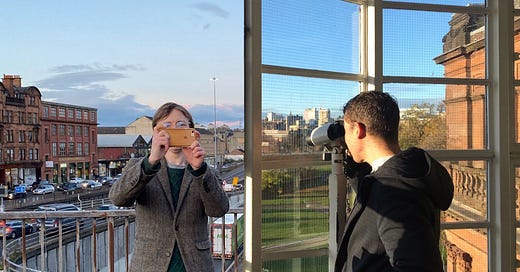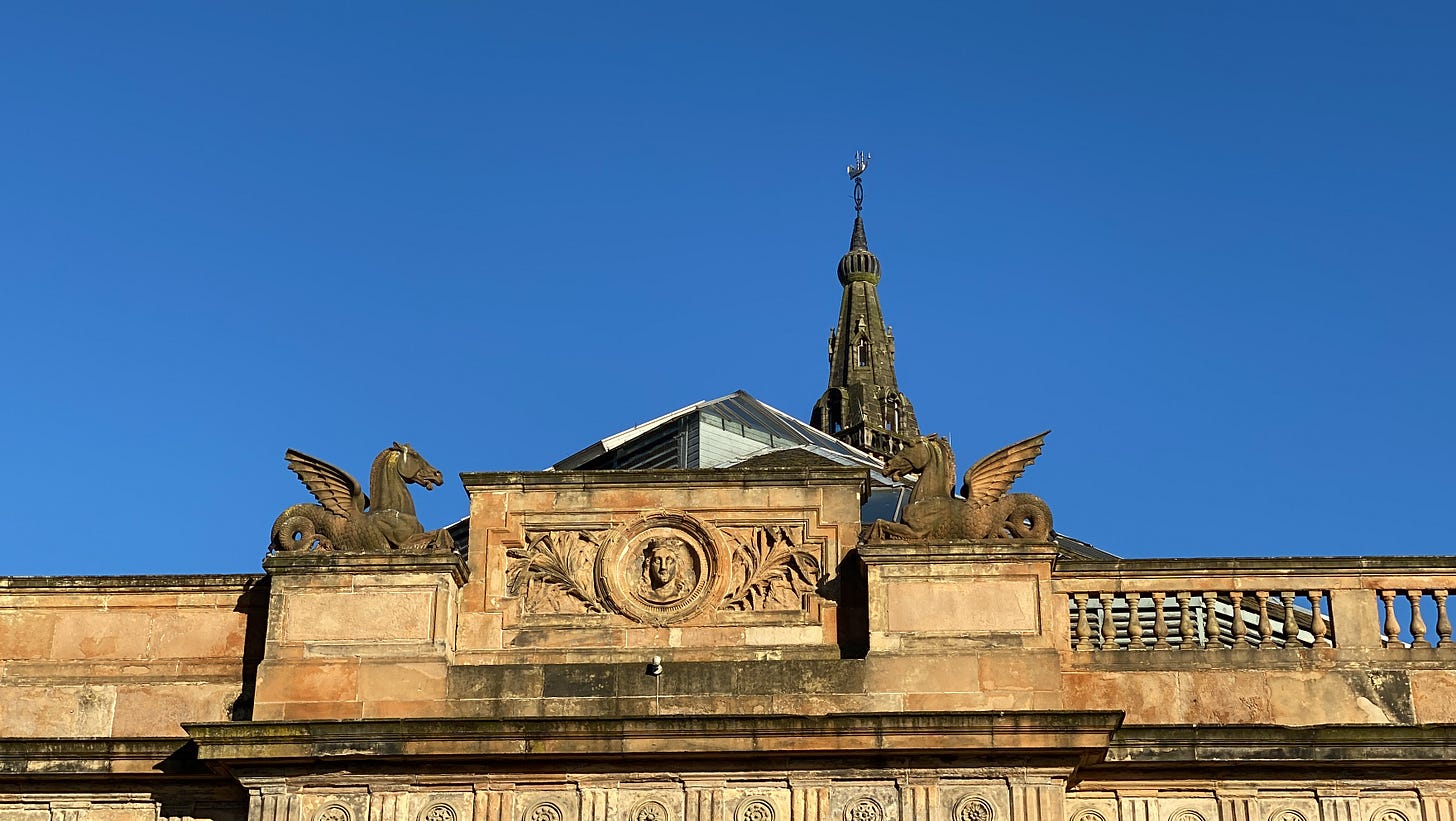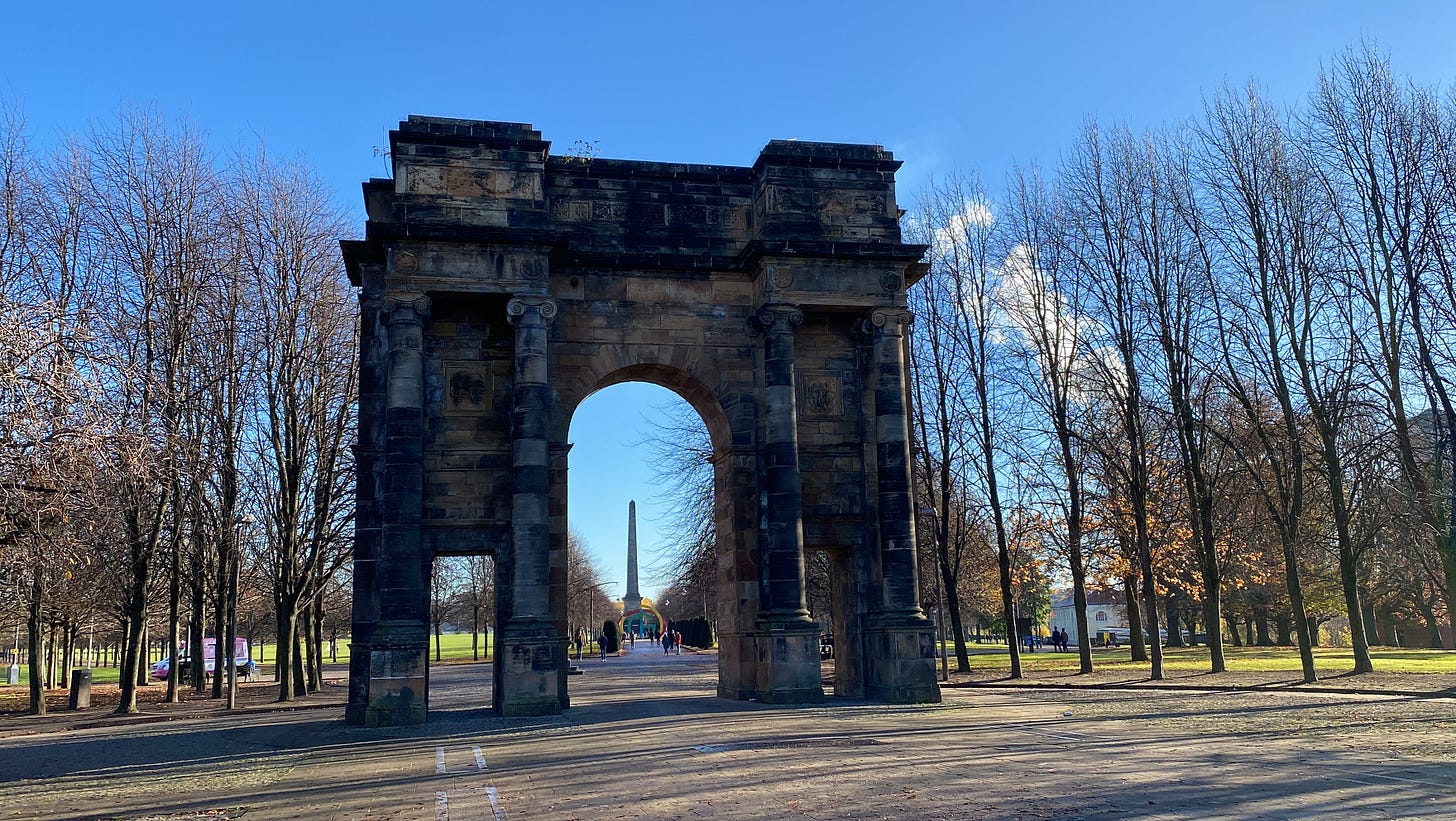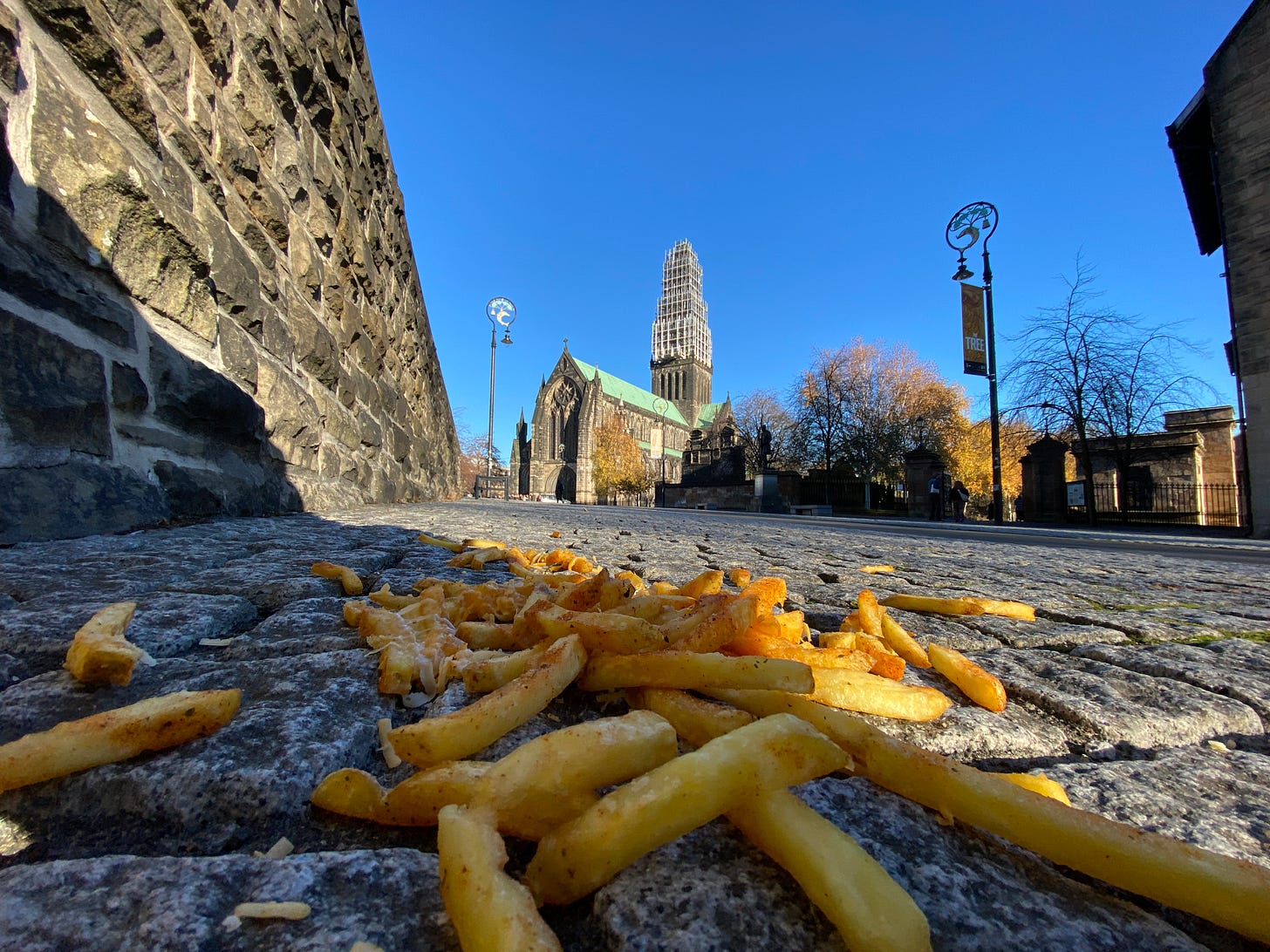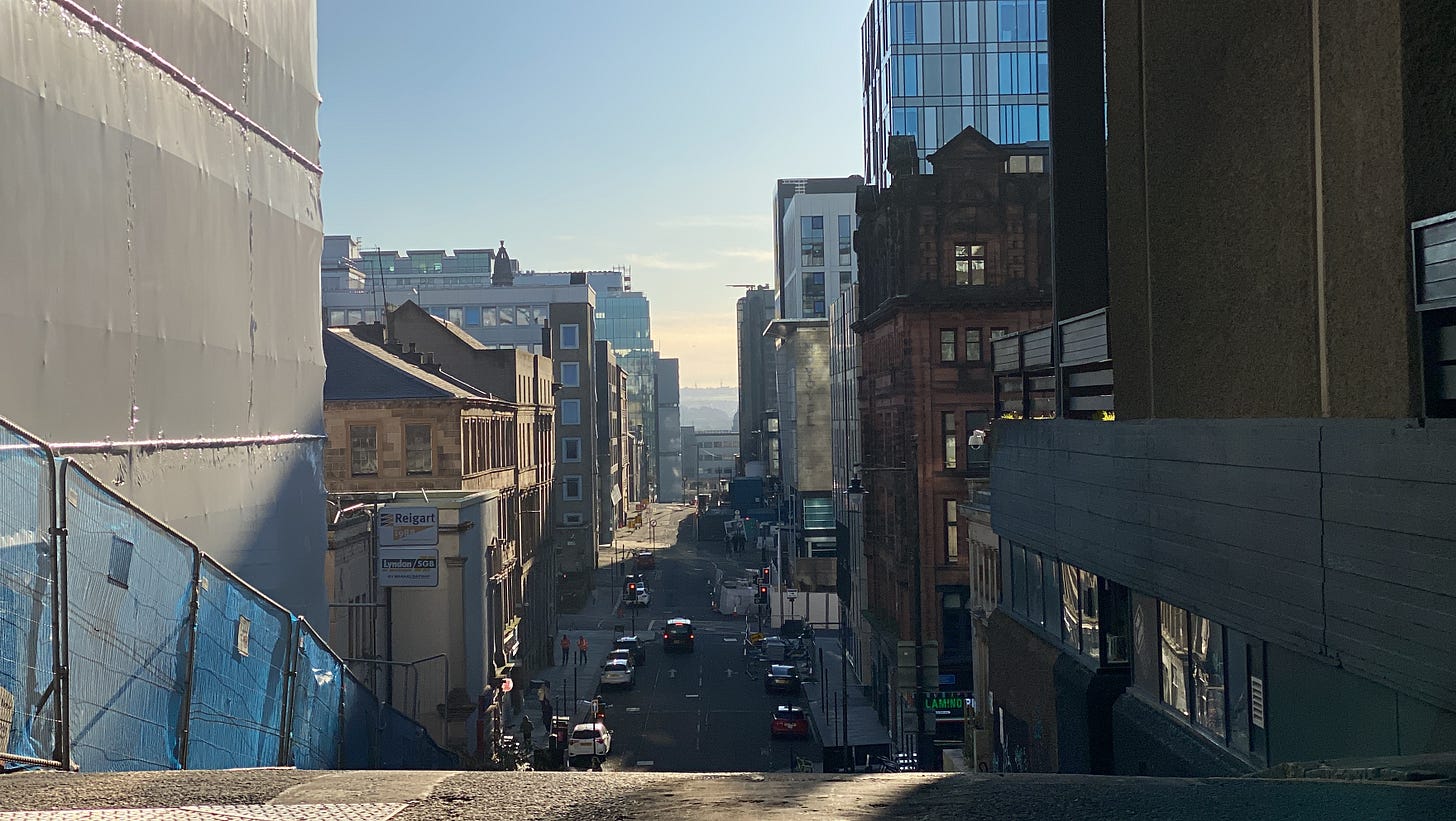Readers may have noticed a collaborative spirit developing between Neil Scott and myself. Neil writes Total Integration. Total Integration has a lot in common with this substack, particularly the broad stock of topics we think about. We both try to cover anything which is of interest and, as Neil puts it, to stay curious.
Cities demand curiosity. Cities hurl stimuli at the viewer with indifference to the viewer’s mood. Walking through a city is an un-curated experience, a gallery of architect’s dreams headbutting reality, social enterprises and social ills, and the perfumes of international cuisines, car fumes, and aftershave.
Appropriately enough, I had the chance to meet Neil in his city, Glasgow. Neil knows the city well. He put together a tour and walked me through it with a simple mission: solve the problem of Glasgow. Glasgow is a great city, an elegant city—enviable actually. But it’s not without its flaws, and then there’s the mystery of what makes Glasgow Glasgow.
What follows is a dialogue of sorts, based on the sights that Neil picked out. It’s not a verbatim recording but rather a considered dialogue written up after the fact, pegged to the itinerary of our walk. Neil gives his considered view in bold as a citizen of Glasgow, I give my view as a casual spectator, in plain text. A video version of the tour is available here.
In the classic 1994 film, London, Patrick Keiller attempts to understand what he calls the problem of London. The narrator and his friend Robinson are flâneurs attempting to understand the deep history of the city. I was reminded of Keiller's film when a young heritage consultant I met on the internet, who is himself called Robinson, mentioned that he was going to be in Glasgow and wondered if he would like to do a psychogeographical dérive in the city.
I had recently been in Liverpool, a city that shares a similar history to Glasgow and was struck by how much more functional it was. People talk of the Glasgow Effect, where people die younger here than elsewhere, but the crisis runs deeper. Buildings are mysteriously torched. Every surface is covered in graffiti. It is a dirty city. A city that has lost its way.
I, on the other hand, only knew Glasgow from one visit in 2022, when I had visited for the previous year’s whisky festival. I last saw Liverpool in 2015. I found Liverpool rather cleaner than Glasgow, but the bit I recall is the most touristy, and rather sanitised docks. Scott said he hadn’t been there this time. I had warmed to Glasgow on my first encounter, and I was looking forward to seeing a bit more.
We arranged to meet on a sunny afternoon by the Wellington statue, the defining symbol of modern Glasgow. Wellington, the nemesis of Napoleon, enabled the British Empire to dominate the world in the nineteenth century. As a port city dealing in transatlantic trade, Glasgow flourished to become known as the second city of the empire, behind only London in glory.
Now the statue is best known for wearing a cone. What a comedown. The cone, frequently replaced, is Banksy's favourite work of art. It is about the gallus cheek of Glaswegians. But it is a joke on the past. It doesn't offer anything to the future, it doesn't build the new.
I could only agree with that analysis of the top brass. But it also speaks to one of Glasgow’s unique features, its inhabitants. Crossing west from Edinburgh into Glasgow is like crossing east from Belgium to the Netherlands: everyone suddenly gets a lot nicer. The humour of Glasgow, its sense of drive and direction makes it great in spite of the various acts of violence that have been done to the city’s built fabric.
Robinson hadn't eaten lunch and was too hungry to solve the problem of Glasgow, so we went back to my flat where he could but prepare the pickled herring he had brought from Germany.
I enthused about the salt-adulterated herring to Neil and gave him a try on a similarly smuggled Laugenbrot. Neil daringly tried it but appeared to have a limited appetite. It is history on a plate, the marker of resourcefulness and success on the North Sea, the Hanseatic League’s lasting culinary expression. It is also really quite fishy and slimy—so no hard feelings that it did not resurrect Neil’s hunger.
Coincidentally, close to my flat is The Briggait, the city's former fish market. Now, predictably, artist studios. The Hippocamps that adorn the building are the only reminder of its former use.
It’s a pleasing and rather muscular piece of neo-Renaissance architecture. It looks superb in the boreal sun.
On Glasgow Green, we see the McLellan Arch, which I mistakenly thought was a monument to a temperance campaigner. Robinson was in Glasgow for a whisky festival, so I felt it my duty to warn him of the dangers of drink.
Fortunately, in Britain at any rate, the Temperance movement produced no effect whatsoever. They won in the United States and it was a great act of cultural vandalism. The great hard cider making tradition of the eastern States is only just recovering.
Alcohol is a problem in Glasgow but so is lack of activity. Where is the much-vaunted Commonwealth Games legacy? As well as a statue of Wellington, Napoleon's other great foe, Horatio Nelson, is celebrated with an obelisk in the middle of the green. It is off-centre, giving it a three-dimensional quality.
"I prefer that obelisk," said Robinson, pointing to the chimney of the Chivas Regal factory across the river in the Gorbals.
Nothing is quite as sublime as a vast chimney billowing fumes. This one was surrounded by less-than-pretty industrial cuboids for extra effect. I don’t see much of this kind of thing in Cornwall.
We approached the sadly neglected Winter Gardens. The story I heard is that one shard of glass fell and then the whole building was condemned. A great loss for lovers of plants. On the other side is the People's Palace, a history of the people of Glasgow, where pilgrims gather from around the world to see Billy Connolly's banana boots.
We did go inside the People’s Palace and we saw the said boots. I found myself looking up at the moulding profiles of the ceiling and imagining what they would have looked like before their (almost certain) polychromed surfaces were censored by white paint in the 20th century.
On the east side of the park is the Templeton Carpet Factory, a Victorian recreation of the Doge's Palace in Venice. Robinson is impressed, although slightly less so when I mention that The Cultural Tutor, an account on Twitter, had posted about it recently.
Scott’s reference to the Cultural Tutor was a bit of a wind-up—he referenced him with a grin. The Cultural Tutor specialises in ruining millennia of cultural history by shoehorning block-headed social conservatism into the mix. Its political bent leads to amusing mistakes, like singling out Cologne Cathedral as an example of hand craftsmanship (it was famously completed in the 19th century with mechanical tools).
During the Black Lives Matter protests of June 2020, a great number of statues were toppled and I was sure that the fragile terracotta of the Doulton Fountain would be damaged. It is, after all, a monument to colonialism with Queen Victoria presiding over soldiers who stand on top of subject populations in the colonies.
This is a good point: she is an incredibly obvious, incredibly haughty target. It was such a strident monument to crushing the underdog. Perhaps it is so colonialist that it hid in plain sight?
Is the problem of Glasgow its toxic history, its hundred years of bad karma? In nearby Calton, the life expectancy has been as low as 54 for men, worse than any warzone. But investment in the Barras market has left it looking clean and welcoming.
We are in historic Glasgow. Near the pub where Boswell and Johnson stopped in on their tour of Scotland, heading towards the High Street, the former heart of the city with its recreation Mercat cross and old clock tower.
Like the obelisk, there is an intriguing off-centre composition here, formed by the old clock tower and Trongate Steeple beyond. The Trongate Steeple is Gothic; the clock tower is Renaissance. Both are rugged and vertiginous bits of architecture: fundamentally Scottish.
The factory smoke and the squalor pushed the middle class out West, but the oldest house is on High Street, near the cathedral. In the necropolis, John Knox commands a view over the city. More bad karma?
Glasgow’s ecclesiastical centre is marooned on a promontory. I suppose this is quite odd for an inhabitant, but it’s quite a contrast for a casual visitor.
Robinson and I arranged to meet Peter, our philosopher friend, who had finished work for the day. We head to Sauchiehall Street which is a grim sight as the department stores have closed one by one. Solving the problem of Glasgow means solving the problem of what to do with high streets when people buy everything online.
The ABC concert hall is a sad shell, which burned with the Glasgow School of Art in 2018. The first fire at the art school was caused by contemporary art. The second remains undetermined, but it is sad to see the building wrapped in plastic.
We head West, down towards the flyover crossing a dozen or so lanes of traffic. How can we solve the problem of Glasgow when faced with this? "Three words”, said Robinson, “replace the M8." It is a scar on the city, it's true. Ugly, noisy, polluting, and dividing it in two. But what is worse, I think, is that it encourages people to move out of the city, safe in the knowledge that there is a quick and convenient route for suburbanites.
I was just as aghast seeing the ** the second time. What’s more, the experience of coming into the city via these colossal roads (I came from the airport by bus) reminded me of one place: Bangkok. Bangkok is cut to ribbons by raised roads that alienate buildings and isolate pedestrians. So with Glasgow. There is something menacing about road projects like this, the megalomaniacs of automotive planning getting their way.
Keiller's film says the problem with London is that it is a city ruled by suburban politicians. Glasgow is a city surrounded by rich suburbs, who continue to enjoy the pleasures of the city without actually contributing to it. The M8 has to go.
We’re agreed on that. But to me Glasgow remains a thrilling city, one with attributes quite unlike any other in Britain, and especially unlike those of Edinburgh.


